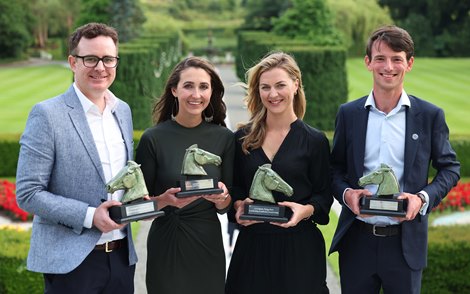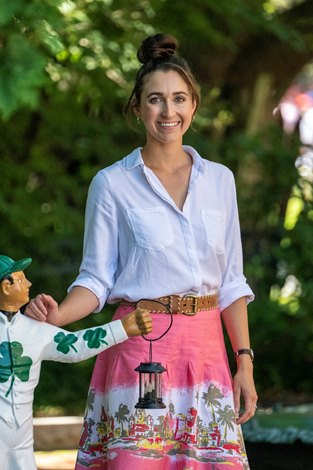As the executive director and co-founder of Amplify, Annise Montplaisir is passionate about giving the tools to youth and young adults to get a leg-up in the racing industry.
As part of its mission statement, Amplify is a 501(c)(3) organization, dedicated to ‘amplifying’ Thoroughbred industry education, mentorship, and career opportunities for youth and young adults.
Montplaisir, who will turn 28 Aug. 5, graduated in 2020 from Godolphin Flying Start, a two-year international Thoroughbred industry management and leadership program. While enrolled at Flying Start, she formulated the idea for Amplify, with her co-founder, Madison Scott, and it launched in 2019.
A cornerstone of Amplify is its mentorship program that started in 2021. Today, with more than 50 graduates, it has an 80% retention rate for those currently working in equine-related jobs. Among Amplify’s industry supporters are racehorse owner John Ballantyne, Breeders’ Cup, Godolphin, Keeneland, The Jockey Club, and the Kentucky Equine Education Project Foundation.
More information on Amplify, including its popular upcoming Experience Saratoga tours, can be found on the Amplify website.
Sign up for BloodHorse Daily
Montplaisir was interviewed July 21, and her answers are edited for clarity and space.
BloodHorse: How does someone from North Dakota with no family background in racing become involved in the industry?
Annise Montplaisir: I grew up as a horse-crazy kid and my mom loved horses. We ended up getting a pony and getting involved in 4-H when I was around 8 years old. When I was 12, I saw the movie “Ruffian,” and thought, ‘Oh, my gosh, I want to be involved in horse racing.’
There is a small track in Fargo called the North Dakota Horse Park and they run anywhere from four to eight days per year. That was my first job, working as a volunteer racetrack ambassador. I worked my way up there to becoming the director of communications. At one point, I was the official clocker. I learned to (gallop) and pony horses there. I really did a little bit of everything. That was my jumping-off point to a lot of other internships in the industry and it really helped to fuel my determination to get involved in the sport.
BH: How did the Godolphin Flying Start program further your education?
AM: For somebody coming from a background like mine, who had pretty limited opportunities from the beginning to get involved in the sport, it really helped to open my eyes to a wider breadth and depth of opportunities that the industry could offer.
The capstone project at Flying Start is a business plan and Amplify was my business plan. The program really helped to put me on the path that I am now.

Montplaisir (second from left) receives a Godolphin Flying Start award for Business and Leadership Excellence
BH: How did you get the idea for Amplify?
AM: The inspiration probably came from my own pathway into the industry as well as that of my (Amplify) co-founder, Madison Scott, who is now with Solis/Litt Bloodstock. Madison no longer is heavily involved in Amplify, but she is a board member. Like me, Madison had a very roundabout way on how she got involved in racing.
I had so many people open to mentoring me and opening doors for me. I went through several youth educational programs with the American Quarter Horse Youth Association. Quarter Horse racing has a lot of amazing youth opportunities. I always knew I was passionate about creating opportunities for youth to be involved in the Thoroughbred industry. Until Amplify, we didn’t really have a national organization collectively working to promote existing educational and workforce opportunities with Thoroughbreds.
We wanted to start something that gave youth a voice in the industry and to create more streamlined pathways to lead to involvement.
All of that evolved into Amplify.
BH: How did you get Amplify from being an idea on paper to a reality?
AM: It started by gathering mostly young professionals who worked in the industry. We gathered them into a room and started taking input on what they felt could be created in the industry that could be important for young people.
Amplify definitely went through an evolutionary phase where it started as more of a young professional group. From there we transitioned to focusing on youth and entry point (opportunities) for them in the industry. During the business plan process you go through a lot of customer discovery by reaching out to people both inside and outside the industry to hone in on what the problem is we are trying to solve and then coming up with solutions.
BH: What was the takeaway?
AM: That we were not doing a great job in the industry promoting or amplifying the existing opportunities for youth to know how to get involved. There was no strategic pathway; once a youth says, ‘Hey, I want to get involved in the Thoroughbred industry’ it was really by word of mouth. You had to meet the right person or mentor to connect you to another person (and so on).
We want Amplify to be a first step for youth to be involved in the industry and to highlight and amplify the existing pathways that are out there.
BH: Can you give me an example of how Amplify has helped someone looking for that leg-up?
AM: Rachel Wagley is a great example. She happened to be doing an internship at the Kentucky Horse Park and learned about an industry career discovery event that Amplify was putting on at Fasig-Tipton. She came to that. By the end of that day, she had secured an internship at Airdrie Stud. She also did an Amplify mentorship program that pairs youth and adults, around the ages of 15 to 25, with an industry professional who will work with them over the course of three months to develop an educational training plan to get them more involved in the industry. Rachel’s mentor guided and advised her in her pursuit of applying for a Fulbright Scholarship and she ended up being a finalist. Her Fulbright application was geared toward Latin American involvement in the United States Thoroughbred industry. Although she didn’t get selected for the Fulbright…she is still hoping to pursue working in the industry using her Spanish and creating resources to help support the Hispanic racing community in the U.S.

Montplaisir speaks to a group of youngsters during one of Amplify’s Experience Saratoga tours
BH: During the Saratoga Race Course meet, Amplify has been offering meet-ups in the mornings. A few dates are upcoming: Aug. 10, 17, and 31. What takes place at these events?
AM: Our Experience Saratoga tours are one of our original events. Part of the reason our name is Amplify is that we want to promote existing initiatives that are (already) in the industry and then enhance their educational value. We approached (the New York Racing Association) in 2019 and we said you already do these awesome trolley tours of the backstretch, can we do something that is more geared toward youth and young adults? Make it more behind-the-scenes and career-orientated to highlight the variety of opportunities that are in the industry while getting people an inside look on what it takes to make a day of racing possible.
We work with NYRA (New York Racing Association) and (the New York Thoroughbred Horsemen’s Association) with putting these tours together. We take the trolley to the backstretch and watch morning training, go to a trainer’s barn, pet the horses, feed them peppermints, and learn about what goes into becoming a trainer. We go out on the turf course and learn about turf course maintenance. We have an aftercare segment where we work with Rick Schosberg and NYTHA to talk about initiatives. We usually meet with a veterinarian as well. In the afternoon, we go to the races and learn about the paddock and how to read a racing program. We are going to have a talk about equine safety technology that NYRA is utilizing. Every event can be a little bit different because we go to different (departments at the track) based on people’s availability.
If people ever have special requests for programming they would like us to do for a certain group, I would encourage them to reach out. Since we’re still developing and growing, I’m always looking to see how we can collaborate with and serve certain groups we haven’t reached out to before. These behind-the-scenes tours are starting to gain popularity among educators.
BH: What do you see for the future of Amplify?
AM: We are starting to focus more on how we can better connect with agricultural education and Future Farmers of America groups to look at creating a curriculum that is geared around the racetrack. We would bring groups of students to the track and the curriculum could target a lot of their key educational learning points (in a track setting).
It’s going to take a lot of work and a long time to really build (Amplify) and reach the level we want to be at, and to keep serving the industry on a national basis. I welcome people to reach out and support us how they can, whether that is becoming a mentor or an organization that wants to help us develop programming, or donors are always appreciated. This is how all this will happen. But we’re getting there.










Leave feedback about this